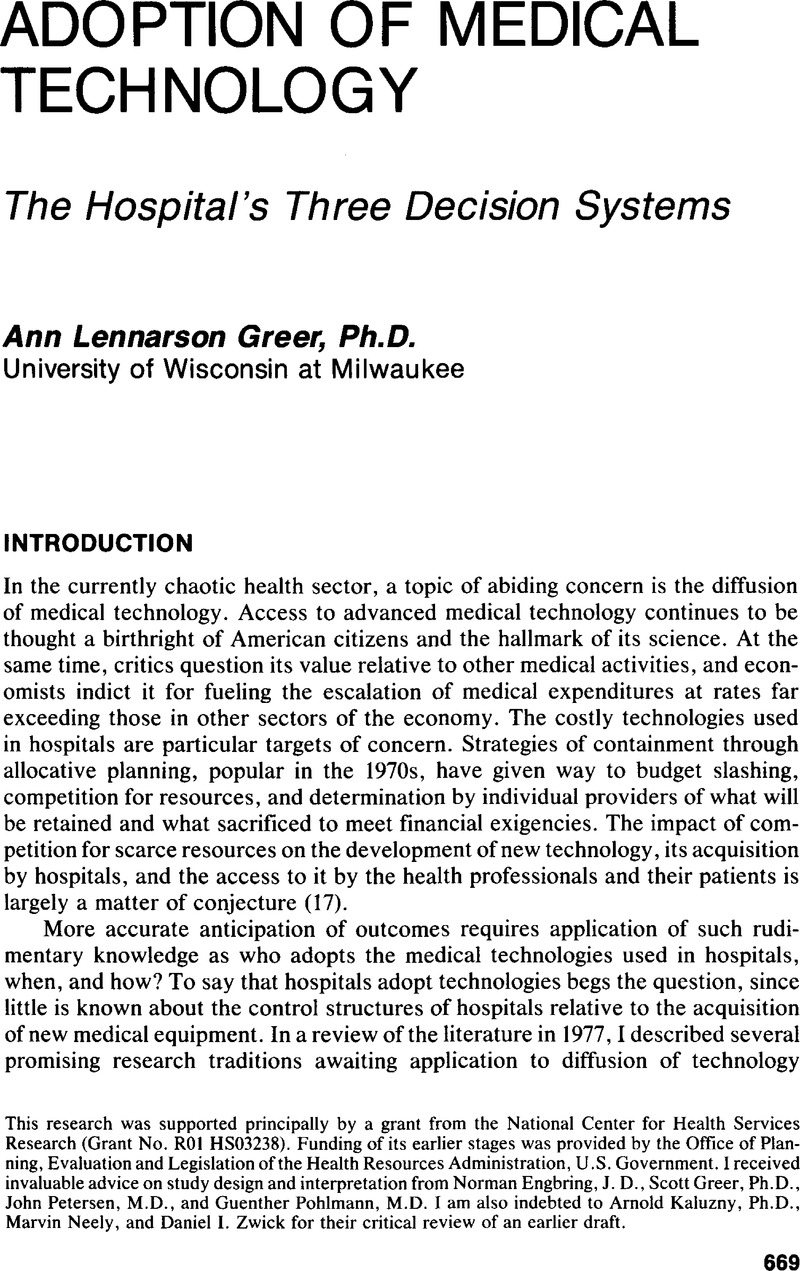Crossref Citations
This article has been cited by the following publications. This list is generated based on data provided by Crossref.
Greer, Ann Lennarson
1987.
Rationing Medical Technology.
International Journal of Technology Assessment in Health Care,
Vol. 3,
Issue. 2,
p.
199.
Kaluzny, Arnold D.
1987.
New Perspectives in Organizational Theory and its Application to Health Services Organizations.
Medical Care Review,
Vol. 44,
Issue. 2,
p.
227.
Deber, Raisa B.
Thompson, Gail G.
and
Leatt, Peggy
1988.
Technology Acquisition in Canada: control in Regulated Market.
International Journal of Technology Assessment in Health Care,
Vol. 4,
Issue. 2,
p.
185.
Greer, Ann Lennarson
1988.
The State of the Art Versus the State of the Science: The Diffusion of New Medical Technologies into Practice.
International Journal of Technology Assessment in Health Care,
Vol. 4,
Issue. 1,
p.
5.
Zviran, Moshe
1990.
Defining the application portfolio for an integrated hospital information system: A tutorial.
Journal of Medical Systems,
Vol. 14,
Issue. 1-2,
p.
31.
ONSRUD, HARLAN J.
and
PINTO, JEFFREY K.
1991.
Diffusion of geographic information innovations.
International journal of geographical information systems,
Vol. 5,
Issue. 4,
p.
447.
Friedman, Leonard H.
and
Jorgensen, Jane
1994.
Physicians' Influence on the Decision to Acquire Magnetic Resonance Imagers in Acute Care Hospitals.
International Journal of Technology Assessment in Health Care,
Vol. 10,
Issue. 4,
p.
667.
Menon, Devidas
and
Marshall, Deborah
1994.
Diffusion of Laparoscopic Cholecystectomy in Canada.
International Journal of Technology Assessment in Health Care,
Vol. 10,
Issue. 2,
p.
287.
Kauer, Robert T.
Silvers, J. B.
and
Teplensky, Jill
1995.
The Effect of Fixed Payment on Hospital Costs.
Journal of Health Politics, Policy and Law,
Vol. 20,
Issue. 2,
p.
303.
Greer, Ann Lennarson
1996.
Managing Technology in Healthcare.
Vol. 1,
Issue. ,
p.
127.
NATTINGER, ANN B.
GOTTLIEB, MARK S.
HOFFMAN, RAYMOND G.
WALKER, ALONZO P.
and
GOODWIN, JAMES S.
1996.
Minimal Increase in Use of Breast-Conserving Surgery from 1986 to 1990.
Medical Care,
Vol. 34,
Issue. 5,
p.
479.
Rosen, Rebecca
and
Mays, Nicholas
1998.
The impact of the UK NHS purchaser–provider split on the `rational' introduction of new medical technologies.
Health Policy,
Vol. 43,
Issue. 2,
p.
103.
Poulsen, Peter Bo
Adamsen, Sven
Vondeling, Hindrik
and
Jørgensen, Torben
1998.
Diffusion of laparoscopic technologies in Denmark.
Health Policy,
Vol. 45,
Issue. 2,
p.
149.
Kumar, A.
and
Motwani, J.G.
1999.
Management of health care technology literature (1979-1997): a multidimensional introspection.
IEEE Transactions on Engineering Management,
Vol. 46,
Issue. 3,
p.
247.
Geisler, Eliezer
1999.
Multiple-Perspectives Model of Medical Technology.
Health Care Management Review,
Vol. 24,
Issue. 3,
p.
55.
Rosen, Rebecca
2000.
Applying Research to Health Care Policy and Practice: Medical and Managerial Views on Effectiveness and the Role of Research.
Journal of Health Services Research & Policy,
Vol. 5,
Issue. 2,
p.
103.
Bozic, Kevin J.
Pierce, Read G.
and
Herndon, James H.
2004.
Health Care Technology Assessment.
The Journal of Bone and Joint Surgery-American Volume,
Vol. 86,
Issue. 6,
p.
1305.
2005.
Diffusion of Innovations in Health Service Organisations.
p.
296.
Greenberg, Dan
Peterburg, Yitzhak
Vekstein, Daniel
and
Pliskin, Joseph S.
2005.
Decisions to adopt new technologies at the hospital level: Insights from Israeli medical centers.
International Journal of Technology Assessment in Health Care,
Vol. 21,
Issue. 2,
p.
219.
Danjoux, Nathalie M
Martin, Douglas K
Lehoux, Pascale N
Harnish, Julie L
Shaul, Randi Zlotnik
Bernstein, Mark
and
Urbach, David R
2007.
Adoption of an innovation to repair aortic aneurysms at a Canadian hospital: a qualitative case study and evaluation.
BMC Health Services Research,
Vol. 7,
Issue. 1,



